Incorporación a la Academia Chilena de Ciencias los Doctores Pierre Léna y Bruce Alberts
Presentation of Drs. Bruce Alberts and Pierre Léna as Honorary Members of the Chilean Academy of Sciences.
Prof. Jorge E. Allende, Faculty of Medicine, University of Chile
20 de Enero de 2016
Madame President M.T. Ruiz, Madame Vice-President Dra. Cecilia Hidalgo
I consider it a great honor for me to present to the Chilean Academy of Sciences two extremely distinguished scientists and educators who have been elected as Honorary Members. It is also a great occasion for Our Academy to have with us today two persons that truly have Global Dimensions in the interaction between Science and Society. In the year 2000, I had the privilege of representing the Chilean Academy in a historic meeting in Tokyo, Japan titled “ Transition to Sustainability in the 21st Century” This meeting was opened by the Emperor of Japan and was attended by representatives of 54 Academies and resulted in the official Foundation of the Inter Academy Panel on International Issues that was committed to represent to the world the views and concerns of the Scientific communities in our planet. I had met Bruce Alberts before because he was at that time President of the U.S. National Academy of Sciences and he had been to Chile in 1993 when I was President of the Chilean Academy and we had a General Conference of ICSU in Santiago. He had also been to Chile when this country started the Millenium Initiative with the World Bank.
However, I had not met Pierre Léna previously . I actually only met him when the three of us came together in the podium of this Tokyo Conference because a session of that Conference was dedicated to science education and the three speakers that participated in that Conference were Bruce Alberts, Pierre Léna and myself. I remember very vividly that session because for me, it was a moment of discovery, of epiphany in biblical terms, because it opened for me a new concept since both Bruce and Pierre spoke of what their academies had been doing with inquiry –based science education of children in primary education. The U.S. National Academy in conjunction with the Smithsonian Institution had started in the eighties with what was called the National Sciences Resources Center which had developed dozens of modules to help children learn basic scientific concepts like the properties of matter, the weather in our planet, the chemistry of food, etc. This approach was a very different way for teaching science because it centered on the action of the students learning by doing what scientists do in their laboratories when they try to answer a question that they have about nature. They formulated a hypothesis that could explain the phenomenon they are interested in explaining, and then, they put those hypotheses to the test of experiments designed to see if those ideas were right or wrong. The experimental results are then analyzed and conclusions and extrapolations were proposed as a result of those experiments. This is different from the traditional way in which a teacher gives a class and writes on the board a lot of strange names and long equations or formulas. This new method of teaching has a great impact on the students who find now that science is fun, that is a game of pitching your intelligence to understand phenomena that are all around us. Since IBSE is always done using groups of several students working together, this method teaches the value of team work and the need to respect different ideas.
Pierre Léna in that Conference told us the story of how the French Academy of Sciences , one of the oldest and most distinguished of these institutions came to embrace this methodology.
It again happened due to international contacts between scientists . George Charpak, a French scientist who had won the Nobel Prize in Physics in 1992 had visited Leon Lederman, an American who had also won the Nobel Prize in Physics in 1988 and who lived in Chicago. Dr. Lederman took Dr. Charpak to visit a school in Chicago where they were using IBSE. Georges Charpak was so impressed by the enthusiasm that the students of that school had for the new method of learning science that upon his return to France he addressed the French Academy and convinced its members that they should adopt this new method of science education. In 1995 the French Academy launched its Program La Main a la Pâte and with the enthusiastic support of Pierre Léna and Yves Queré they were able to obtain the very important support of the Ministry of Education of France It is very interesting also that the French Ministry of Foreign Affairs has been very actively involved in supporting the spread of La Main a la Pâte to many countries in Europe and in many other parts of the world. The French Embassies in Latin America have been very active supporters of the efforts of the French Academy to spread this method of education in our region. The epiphany that I received in the Tokyo Conference from the presentations of Bruce Alberts and Pierre Léna was very potent because this new method of teaching gave a very active role to the Scientific community to participate in the implementation of IBSE in the schools at all levels. The participation of the scientists in the professional development and in the initial training of science teachers became essential and the generation of the new teaching modules became a joint venture between scientists and educators. The Chilean Academy and the University of Chile embraced this new approach and with the very enlightened participation of Rosa Devés and Minister Mariana Aylwin we were able to start the ECBI program in March of 2003 in the Municipality of Cerro Navia. This start was greatly helped by Bruce Alberts who introduced us to Doug Lapp and Sally Shuller, the main authorities of the NSRC in the Smithsonian who gave us a great support in the form of donating to us all their excellent modules and also sending us sample kits of the materials needed to implement those modules. Guillermo Fernández who is also present here today and who had started a FUMEC IBSE program in México also was very supportive in providing Spanish translation of the NSRC modules. Finally, the Smithsonian Institution accepted a group of Chilean scientists and educators to participate in July 2002 in a LASER Workshop at the Smithsonian in Washington where they got all the details of how start a project in this methodology. Pierre Léna also contributed in a key issue by inviting Minister Mariana Aylwin, when she went to a UNESCO meeting in Paris to visit a Main a la Patê school in that City. She was completely sold on the IBSE methodology and gave us a solid support to start the project. Another person that played a key role was the Mayoress of Cerro Navia, Cristina Girardi who is now a Deputy of the Chilean Congress. As Mayoress of Cerro Navia, she instructed her Director of Education, Mr. Santiago Aranzaez to give high priority to improve science education. We are now fortunate to have her now as a member of the Education Committee of the Chamber of Deputies, where she continues to support the initiatives in science education. But the two persons that our Academy is today receiving as Honorary members are exceptional scientists who have made huge contributions to our Knowledge in their respective scientific fields and I must mention some of their key discoveries.
Bruce Alberts has done an outstanding work in a key reaction for all living things. One of the essential characteristics of life is its capacity to self-replicate. The advances in molecular biology of the last 60 years have demonstrated that this unique capacity is due to the existence in living cells of a whole complex machinery of proteins that can carry out the incredible task of replicating with great accuracy and fidelity the genetic information contained in the DNA of that cell. To give you an idea of this amazing process, we can consider that the DNA of the human genome has 3000 million letters. It would take a book of a million pages to print that number of letters. And yet this replication can be accomplished in times fluctuating for 24 to 45 hours for cells in human cells.
Dr. Alberts contributed greatly to clarifying the different components of this amazing biological machine that can copy both strands of the DNA that are antiparallel so that the machine is copying one strand in one direction and the other strand in the reverse direction. It is enough to say that he spent 16 years in trying to solve this problem until in 1976 he was able to add 7 different proteins that he had purified and was able to replicate DNA and its information. Along the way he told an interviewer that he had many failures and said a phrase which all young scientists should remember: “Success in an experiment can teach you very little but there is a lot that you can learn from a failure”. But in spite of his statement Dr. Alberts has had a lot of successes as a scientist and as a leader of scientific institutions.
For instance when the National Academy of Sciences asked him to chair the Human Genome Panel when that project was being proposed in the late 80’s and early 90’s and was able to get the panel to agree – a very difficult task because there were many people against the idea of his huge project in the beginning. This success demonstrated his leadership capacity and not long afterwards, in 1993 he was elected as President of the Academy, position that he held for 12 years . One of the reason he accepted this position which meant that he had to take the very painful decision of closing his laboratory was that as Academy President, he could do more for science education and, that he has achieved this, is shown by the fact that in the award of the National Medal for Science in 2014 of the USA. to Bruce Alberts, gives as a reason of this award “for intellectual leadership and experimental innovation in the field of DNA replication and for unparallel dedication to improving science education and promoting science-based public policy” One of his landmark accomplishments in this field has been the Committee on National Standards and Assessment of Science Education. I have not mentioned another very impressive accomplishment which was being the senior author of the most widely used text book Molecular Biology of the Cell. This book is now in the 6th edition and is used all over the world – When I told a young girl student here in Chile that Dr. Alberts was coming to Chile she said “I go to bed with his book every night.“
Now I must turn to a watcher of the skies, as Keats says in his poem “On first looking into Chapman’s Homer” which is a masterful description of the amazement that we feel when we see a beautiful thing in nature or in art. He felt that way in reading Chapman’s translation of Homer and he compares it to the feeling of a watcher of the sky when a new planet swims into his ken and also the feeling of “stout Cortes” when in a peak in Darien Panama he gazed at the immensity of the Pacific Ocean. I am certainly incompetent to talk about the great contributions that Professor Pierre Léna has made to astronomy and astrophysics research. There are several persons in the room that could do much better than I.
However, he obviously has done some very pioneering work exploring the infra red skies with ground, airborne and satellite devices and he created new techniques for high resolution imagins (Interferometry and adaptive optics). Dr. Léna was the representative of France in ESO Council, the European Southern Observatory, and as such he played a most important role in the conception of the ESO very Large Telescope in Chile. He also has trained many young Doctoral students in astronomy, one of them, Dr. Pierre Cox, the present Director of ALMA Observatory who is here with us this evening. He has received many prizes and recognitions like the Legion d’Honneur that was awarded by France in the rank of “Commandeur de l’Order du Merite“, the Holweek Prize in Physics from the Physics societies of France and the United Kingdom, the Erasmus Prize of the Academia Europea, He is also a member of the Academy of Sciences of France, of the Academia Europea, of the Pontifical Academy of Sciences and of the Academies of Argentine, Venezuela, Serbia and Senegal and now of our Academy in Chile. Even before he joined Charpak and Queré as Founders of La Main a la Patê in 1995, he was President of the Institut Francais de Recherche Pedagogique (1991-1997) and in the French Academy of Sciences he was the head of Education and Formation Section. In a recent interview with Marlene Rau, Pierre Léna makes the very important point that science is a “human and collective adventure, not a lonely and national activity” In that interview- he tells the story of how Thomas Young a very young man of 20 years, was walking in a park in Cambridge when he saw two swans majestically moving in a pond and making waves and he noticed that the waves were interfering and he makes the point that if you tell this story to children the children, will always remember the swans and they will have a much better understanding of what interference is than if you had written an equation in the board and told them this is interference. Then he makes the point that Science is a process of thinking, which triggered by admiration, emotion and surprise and that we should convey all of these feelings when we teach children what is science. Science is a lot of fun for all the Children of the world – He is a true believer in the dictum that the more you share your knowledge, the more the knowledge will grow. This is the secret of the success of La Main a la Patê which in 20 years has been able to have a presence in 60 countries in all continents. It is a wonderful experience to know this watcher of the skies who has his feet on the ground and spends all his energy on helping his neighbors and for the Chilean Academy it is a fantastic honor to have two new outstanding Honorary Members as Bruce Alberts and Pierre Léna. One uses a telescope to search the confines of the Universe, the other uses a microscope to look a the essence of life but both also look around with admirable compassion to see what they can do to help their fellow human beings all over the world.




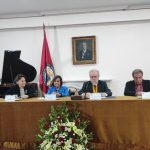
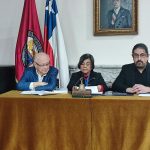
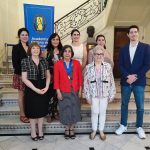
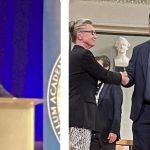
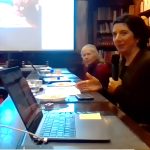
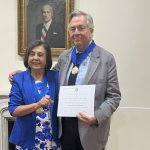

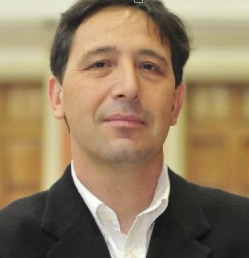
Leave a reply